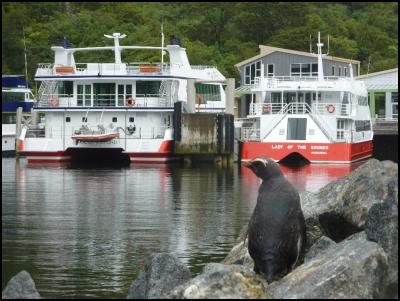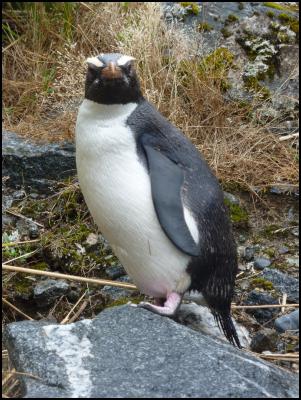January 22, 2012

STEPHANE DE SAKUTIN/AFP/Getty Images
By BRANDON OLAND
Carroll County Times
BALTIMORE (AP) — The 52 African penguins at The Maryland Zoo in
Baltimore will chew on shoe laces, hide underneath rocks and skirmish
among themselves.
They are a curious, stubborn, squawking lot. The keepers at their
Rock Island habitat, the zoo’s penguin exhibit since 1967, have their
hands full. Always.
“This is kind of like having a day care with a bunch of 3-year-old
kids sometimes,” said Jen Kottyan, the high-energy manager charged with
their care.
Yet it’s those same quirks that have allowed the waddling,
attention-craving penguins to endear themselves to their human keepers.
Their antics during public feedings draw a crowd no matter the time of
year, including in the winter months when the Maryland Zoo was
previously closed to visitors.
The zoo is open 10 a.m.-4 p.m. Fridays through Mondays in January and February for the second consecutive year.
A few of the species, including some African birds and tortoises, are
kept indoors during teeth-chattering, cold winter days. But most of the
zoo’s more than 2,500 animals deal with frigid weather just fine.
The African penguins seem right at home. The species is native to the
rocky coastline of South Africa and Namibia and its temperate climate.
Only a few penguin species live as far south as Antarctica in the wild.
The zoo’s penguins are free to meander about outside as long as their
250,000-gallon moat is not completely frozen over. If it gets too
chilly even for them, they can retreat to a heated indoor sanctuary.
When the domesticated penguins spot caretakers and visitors inside
their habitat, many of them wander over. And that’s when the fun starts.
Depending on their moods, the penguins will peck at pant legs,
surround their human counterparts or jostle with each other. If one of
their human handlers omits a yell that sounds like a braying donkey, the
penguins will mimic it.
The high-pitched squawk is the reason why the African penguins are nicknamed the jackass breed.
“We don’t like to call them that,” Kottyan said, “but the kids get a kick out of it.”
During a public feeding Friday, the penguins gathered while
caretakers flung herring, capelin and squid at the group. The penguins
each eat about a pound of fish each day. Their human overseers closely
track how much each penguin in the group eats.
Two of the zoo’s four penguin chicks were brought outside for the
public feeding. Four penguin chicks have been successfully bred there in
recent months, Kottyan said, with the most recent one born on Christmas
Day.
The Maryland Zoo has raised more than 800 chicks and plays a role in
the African Penguin Species Survival Plan. The zoo has raised chicks
that are now on display throughout the country at other exhibits.
The Maryland Zoo has the largest collection of African penguins in the U.S.
The African penguins are threatened due to overfishing and frequent
oil slicks in their home habitats, which happen to be near busy shipping
routes for crude.
“If they get coated with oil, they want to clean themselves and wind up ingesting it,” Kottyan said.
The plight of the penguin was featured in major motion pictures “March of the Penguins” and “Happy Feet” in the last decade.
Kottyan said zoo visitors took notice.
“We hear the comments even still when we are out in the public
feeding that our penguins don’t look like the ones from ‘March of the
Penguins,”‘ she said.
That’s because they are a completely different breed. “March of the
Penguins” followed a colony of Emperor penguins in Antarctica. The
2-feet-tall African penguins are roughly half the size of their
Emperor counterparts.
Regardless, Kottyan said the movies sparked an interest in their
plight. African penguins are considered endangered by The International
Union for Conservation of Nature.
The penguin exhibit is among the most popular at the zoo, staffers
said. A few times each year, the zoo holds Breakfast with the Penguins
programs. This year’s programs are scheduled for 8:30 a.m. April 14,
July 6-7 and Sept. 8.
“They sell out every single time,” Kottyan said.
During the events, visitors have the opportunity to eat breakfast,
feed the penguins and learn more about their behavior. They discover
what their caretakers have known for so long: The tiny penguins can be
rambunctious, loving, inquisitive and maddening all at once.
“Working with these guys,” keeper Betty Dipple said, “prepares you for motherhood.”
source

















































